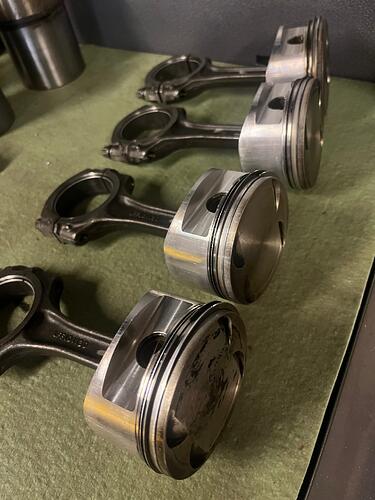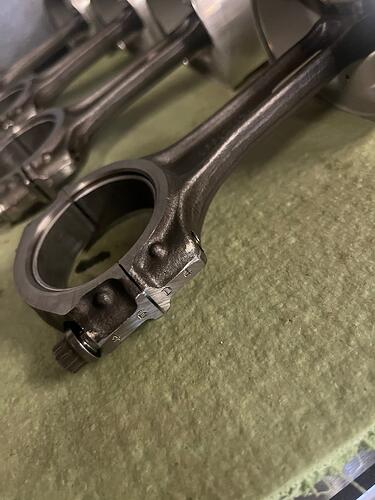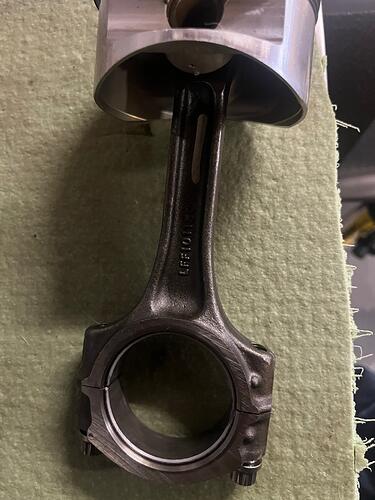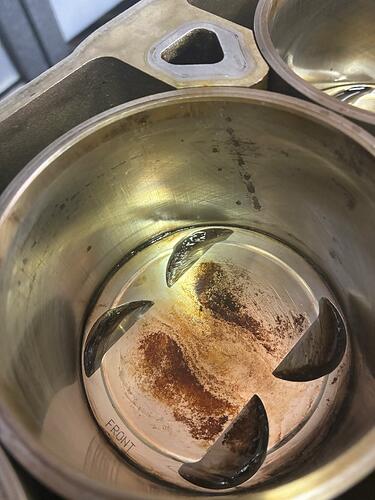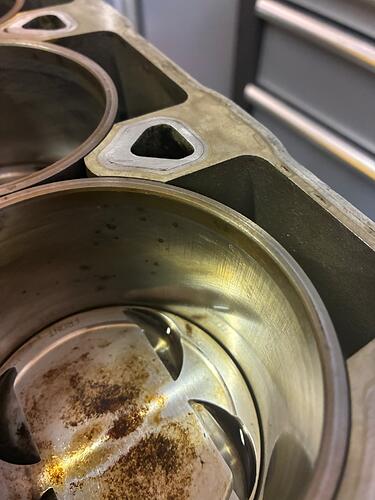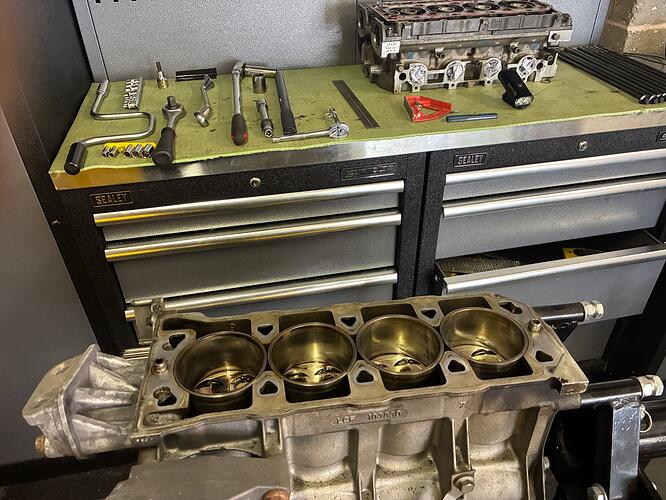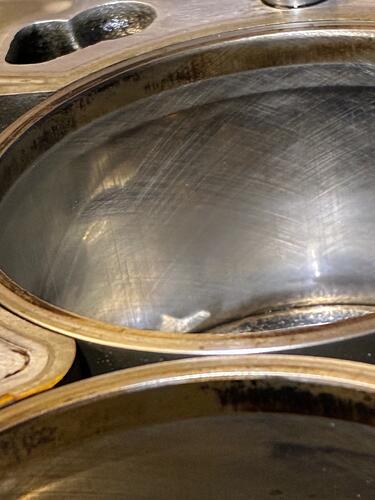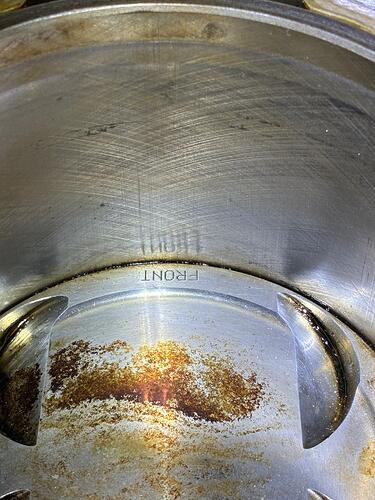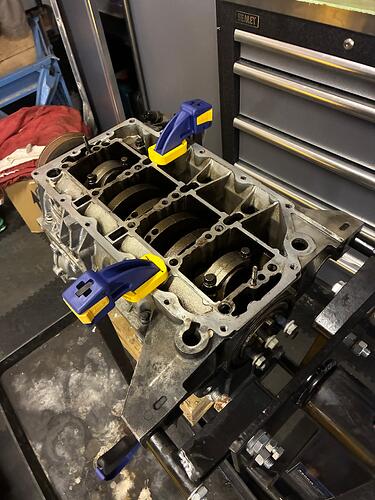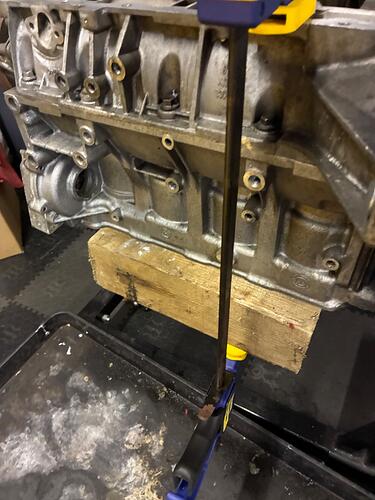Many years ago I did an inspection of my spare VHPD engine and it all looked good. I’ve got a bit more time in semi retirement so I’m planning a rebuild for fun, education and to stop annoying my wife in the house. I started by opening my box of VHPD spares which came from a 310r owner. I have a full set of forged pistons, rods etc. I notice some writing and grind marks, they all weigh within 2 grams of each other. First question experts, were they balanced as std or have these been worked on? 872 grams ± 2 grams is pretty tight! (Looked online, that’s how they should be, better than 0.25pc!).
I’ve added some piccies of my spare piston set, pistons look forged to me and con rods are correct.
2 Likes
I’m on hols atm but plan on doing a bit more in my return, I need to change a liner as one has a spot of corrosion. Probably fine but I have a new one.
Can’t offer you any advice, as don’t know what I’m talking about. I’ve take the easy route and got mine booked mine in for a rebuild. Following your progress with interest…. 
Before changing the liner, given that the K-series is known for liner height/retention issues, it might be worth investigating whether light re-honing would be effective to remove any corrosion. Although the engine isn’t generally one that honing is advised, it may be the less problematic of the two options?
I’ve got my suspicions that the engine may have been turned over with the head off, moving the liners. I plan to check the heights but probably take them all out and refit with/without shims as needed.
I’ve taken the sump off, all clean and the oil feed pipe is all clean, I had got this far before so it was no surprise.
I’ve also removed the head, a quick check with my ancient steel rule and a light shows the liners are above the block (about 3 thou) but I want to measure it more carefully. Three of the liners have a bit of spotting, I can’t feel anything, there is no ridge at the tops of the bores. As the best way to measure liner height a decent rule and feeler gauge? Should I worry about the dots? They look worse in the pictures than real life. Oddly one of them goes above the swept part of the bore and is darker above, implies it was running with the dots present. I assumed they were from water drops in storage.
Update, the black dots clean off with a bit of scotch brite. I’ve decided to leave them alone as they cannot be felt with the finger nail test and scrubbing could cause more harm than a black dot.
I’ve checked liner heights with a straight edge in many places and checking I can shine a torch and see light coming under the edge between the liners. Feeler gauge indications 3 thou when I can measure it.
I’ve now filled it with water to ensure nothing leaks over a few days. If crank has ever been turned with the head off I assume there liners would leak at the bottom where they join the block.
1 Like
Unless it’s just the way your pictures have come out, I’d be concerned about the condition of the liners. They look very glazed with almost no signs of honing?
I think it’s the pictures and some surface grease from storage. I can see (clearly) some light marking which goes at about 15 degrees to the horizontal all the way round on all of them. I’m not sure what good should look like though. Any advice?
Interred says you should be able to feel the honing with you finger nail, I’ll try that!
I can feel the hone with my finger nail. Taken a picture with different light! Looks like the hone stops on the left but it’s the reflection from the piston.
Not a drip of water has come out.
Better picture. I have a spare set of liners from a 340, they look similar but feel a bit more rough on the finger nail test.
1 Like
Much better - I hope you didn’t mind me mentioning though, as the first pics were quite worrying. Providing the hone is evident and capable of holding an oil film they should be okay.
I’m learning, thx for your input.
Today I took the oil rail off, no sign of any RTV sealing it, just cleaned the grime off it. I was going to open the big ends but I don’t have s flywheel on the engine so don’t know how to lock it, worried I could dislodge the liners.
I plan to check and lose assemble the engine (so I’ll insert a red card to indicate the missing gasket(s).
1 Like
I invented a new liner clamp, off cut of “railway sleeper” across all of the liners on the top face, non scratching and takes a lot of force and two wood working clamps.
Only to find my torx socket is too wide so I need to buy another.
2 Likes
Gone quiet but not stopped. I started looking at the MS2 head and decided that it’s not something for me to learn on. I’ve booked it in with the Guru Dave Andrews for a health check and setup. If I need it, it will be perfect, if I sell it, it’s been done by Dave. I know it needs reshimming and the cam wheels were totally out so it’s been tinkered with. It will be a back boiler job for Dave. When the head comes back perfect, I’ll attack the block. If for any reason the head is junk, I’ll not waste my time.
As a side note, my running Exige gets a tiny amount of oil in the water, never any water in the oil. The only place the oil pressure is higher than the water pressure is the feed from the pump, up the block to the head to feed the cams. Evidently some k blocks can be porous letting the oil into the water. Dave A has supplied me with a machined alloy tube which can be inserted in the block. As I’ve had the tiny leak for 10+ years and I don’t want to take a perfectly running engine apart, it’s also in my “just in case” box.
2 Likes
Just caught up with this . . . finding it fascinating. Keep up the good work,Keith
Head dropped off with Dave A today. Brinnell tested and all good. Simple bit of test kit which drops a ball bearing onto the surface and measures the bounce. Low bounce, soft, good bounce, hard. All passed. Dave pointed out lots of little things which I would never have noticed, colour, marks etc. Nothing bad though and plenty of meat left on the head. Dave is going to do a smidge of porting as it offends his sensibility the way it is stock. As it’s my “spare” and I need a new Cambelt this year I’m tempted to have Gavin fit it and keep the original as the “spare”.
I’m so pleased I took the head to Dave Andrews. I could see it was full of soot and oil but he detected that the valves (which passed the air test) were not properly seated or lapped, the manifold faces were not flat and it had been cleaned with a wire brush on a drill. It is all going to be sorted.
Us with S1s need to keep in mind that people like Dave could retire over the next decade. Whilst there are plenty of people who can build engines the vhpd was very low volume and pretty badly made with poor quality castings and poor work over the years. I’m saying that to justify my expenditure on my “spare” engine.
3 Likes
You’re lucky to have a spare engine for sure. Also, good to hear the head is salvageable. Hopefully there’ll be no major issues when Dave works his magic on my engine build later in the year!
Keep sharing any progress photo’s 
